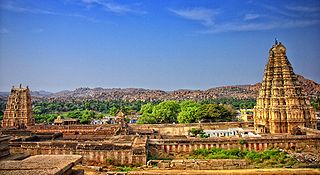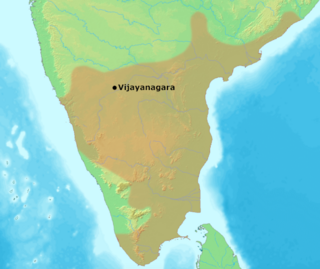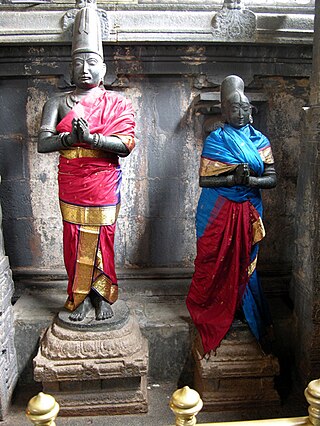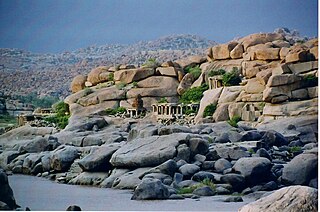Related Research Articles

Hampi or Hampe, also referred to as the Group of Monuments at Hampi, is a UNESCO World Heritage Site located in Hampi (City), Ballari district now Vijayanagara district, east-central Karnataka, India. Hampi predates the Vijayanagara Empire; it is mentioned in the Ramayana and the Puranas of Hinduism as Pampa Devi Tirtha Kshetra. Hampi continues as a religious centre, with the Virupaksha Temple, an active Adi Shankara-linked monastery and various monuments belonging to the old city.

Vijayanagara was a city at the modern location of Hampi, in the Indian state of Karnataka. Vijayanagara was the capital city of the historic Vijayanagara Empire. Located on the banks of the Tungabhadra River, it spread over a large area and included sites in the Vijayanagara district, the Ballari district, and others around these districts. A part of Vijayanagara ruins known as the Group of Monuments at Hampi has been designated as a UNESCO World Heritage Site.

The Vijayanagara Empire or the Karnata Kingdom was a late medieval Hindu empire that ruled much of southern India. It was established in 1336 by the brothers Harihara I and Bukka Raya I of the Sangama dynasty, belonged to the Yadava clan of Chandravamsa lineage.

The history of southern India covers a span of over four thousand years during which the region saw the rise and fall of a number of dynasties and empires.

Krishnadevaraya was an emperor of the Vijayanagara Empire reigning from 1509 to 1529. He was the third monarch of the Tuluva dynasty, and is considered to be one of the greatest rulers in Indian history. He ruled the largest empire in India after the fall of the Islamic Delhi Sultanate. Presiding over the empire at its zenith, he is regarded as an icon by many Indians. Krishnadevaraya earned the titles Andhra Bhoja, Karnatakaratna Simhasanadeeshwara, Yavana Rajya Pratistapanacharya, Kannada Rajya Rama Ramana, Gaubrahmana Pratipalaka and Mooru Rayara Ganda. He became the dominant ruler of the peninsula by defeating the sultans of Bijapur, Golconda, the Bahmani Sultanate and the Gajapatis of Odisha, and was one of the most powerful Hindu rulers in India.

Achyuta Deva Raya was an emperor of Vijayanagara who succeeded his older brother, Krishnadevaraya, after the latter's death in 1529 CE.

Hospet is the largest and fastest-growing industrial city and district headquarters of the Vijayanagara district in the Indian state of Karnataka. Hospet is known as "the steel city of Karnataka". It is located on the bank of the Tungabhadra River and is 13 km (8.1 mi) from Hampi (Vijayanagar). Hampi was once the capital of the Vijayanagara Empire. It has been designated a UNESCO World Heritage Site. Hospet is the connecting link between North and South Karnataka. It is 333 km (207 mi) from the state capital Bengaluru.

Deva Raya I was an Emperor of the Vijayanagara Empire. After Harihara II died, there was a dispute among his sons over succession, in which Deva Raya I eventually emerged victor. He was a very capable ruler noted for his military exploits and his support to irrigation works in his Empire. He modernized the Vijayanagara army by improving the cavalry, employed skilled archers of the Turkic clans and raised the fighting capacity of his bowmen and imported horses from Arabia and Persia.

Nayakas of Keladi (1499–1763), also known as Nayakas of Bednore and Ikkeri Nayakas, were an Indian dynasty based in Keladi in present-day Shimoga district of Karnataka, India. They were an important ruling dynasty in post-medieval Karnataka. They initially ruled as a vassal of the famous Vijayanagar Empire. After the fall of the empire in 1565, they gained independence and ruled significant parts of Malnad region of the Western Ghats in present-day Karnataka, most areas in the coastal regions of Karnataka and the central plains along the Tungabhadra river. In 1763 AD, with their defeat to Hyder Ali, they were absorbed into the Kingdom of Mysore. They played an important part in the history of Karnataka, during a time of confusion and fragmentation that generally prevailed in South India after the fall of the Vijayanagar Empire. The Keladi rulers were of the Vokkaliga and Banajiga castes and were Veerashaivas by faith. The Haleri Kingdom that ruled over Coorg between 1600 A.D and 1834 A.D. was founded by a member of the Keladi family.
The origin of the Vijayanagara Empire is a controversial topic in South Indian history, with regard to the linguistic affiliation of the founding dynasty, the Sangama family. The Vijayanagara Empire rose to power in southern India in the 14th century CE. Over the past decades historians have expressed differing opinions on whether the empire's founders, Harihara I and Bukka I, were of Kannada people or Telugu origin. There are various opinions about role of the Vidyaranya, the Hindu saint and guru of Harihara I and Bukka I in the founding of the Vijayanagara empire.

Virupaksha Temple is located in Hampi in the Vijayanagara district of Karnataka, India, situated on the banks of the river Tungabhadra, a glorious 7th century temple of Lord Shiva. It is part of the Group of Monuments at Hampi, designated as a UNESCO World Heritage Site. The temple is dedicated to Sri Virupaksha. The temple was built by Lakkan Dandesha, a nayaka (chieftain) under the ruler Deva Raya II, also known as Prauda Deva Raya of the Vijayanagara Empire.

Vijayanagara architecture of 1336–1565 CE was a notable building idiom that developed during the rule of the imperial Hindu Vijayanagara Empire. The empire ruled South India, from their regal capital at Vijayanagara, on the banks of the Tungabhadra River in modern Karnataka, India. The empire built temples, monuments, palaces and other structures across South India, with the largest concentration in its capital. The monuments in and around Hampi, in the Vijayanagara district, are listed as a UNESCO World Heritage Site.

The city of Vijayanagara was the urban core of the imperial city and the surrounding principalities of the capital of the Vijayanagara Empire during the 14th to 16th centuries. Notes by foreign travellers such as Abdur Razzak, the Persian who visited Vijayanagara in 1440, mention seven fortifications before the gates to the royal palace. The large area between the first and third fortifications contained agricultural fields, gardens and residences. The notes of Robert Sewell describe countless shops and bazaars (markets) filled with people from different nationalities between this fortification and the palace.

The period of the Vijayanagara Empire is considered an age of prosperity in South India in the 14th century CE. Many travelogues written by visitors, ambassadors and authors of that time provide ample proof of a vibrant era. Agriculture was the main sustenance and the Tungabhadra was the life blood of the capital city.
Fernão Nunes, also known as Fernao Nuniz, was a Portuguese-Jewish traveler, chronicler and horse trader who spent three years in Vijayanagara, the capital of the Vijayanagara Empire in the time period 1535-1537. His writings have brought to light many interesting details about Vijayanagara at that time, including construction of massive fortification works, watch towers and security walls. From his notes it is known that the expansion of the imperial capital limits happened during the reign of emperors Bukka Raya II and Deva Raya I.

The Battle of Raichur was fought between the Vijayanagara Empire and the Sultanate of Bijapur in 1520 in the town of Raichur, India. It resulted in a decisive victory for Vijayanagara forces, and the Bijapur ruler was defeated and pushed across the river Krishna.

Anegundi, previously called Kishkindha, is a village in Gangavathi, Koppal district, in the Indian state of Karnataka. It is older than Hampi, situated on the northern bank of the Tungabhadra River. Nimvapuram, a nearby village, has a mount of ash believed to be the cremated remains of the king Vaali.
Robert Sewell (1845–1925) worked in the civil service of the Madras Presidency during the period of colonial rule in India. He was Keeper of the Madras Record Office and was tasked with responsibility for documenting ancient inscriptions and remains in the region, As with other British administrators of his type at that period, his purpose was not scholarly but rather to bolster administrative control by constructing a history that placed British rule as a virtue and a necessity rather than something to be denigrated. Portrayal of historic factionalism among local figureheads and dominion by alien despots would, it was thought, enhance the perception that only the British could rescue the country from its past.

The Portuguese presence in Asia was responsible for what would be the first of many contacts between European countries and the East, starting on May 20, 1498 with the trip led by Vasco da Gama to Calicut, India. Aside from being part of the European colonisation of Southeast Asia in the 16th century, Portugal's goal in the Indian Ocean was to ensure their monopoly in the spice trade, establishing several fortresses and commercial trading posts.

The Deccani–Vijayanagar wars were a series of conflicts between the Deccan Sultanates and the Vijayanagar Empire that took place from 1495 to 1678.
References
- 1 2 Catherine B. Asher; Cynthia Talbot (16 March 2006). India Before Europe. Cambridge University Press. p. 57. ISBN 978-0-521-80904-7.
- ↑ Hampi on line, visited on 15 June 2009.
- Robert Sewell (1900). A Forgotten Empire (Vijayanagar): A Contribution to the History of India. Asian Educational Services. pp. 235–290. ISBN 978-81-206-0125-3.. Repub. Adamant Media Corporation, 1982, ISBN 0543925889. Includes a translation of the Chronica by Domingo Paes and Fernão Nunes about 1520 and 1535 respectively.
- Radhakamal Mukerjee, "A history of Indian civilization", Hind Kitabs, 1958 (refers to Paes)
- H. V. Sreenivasa Murthy, R. Ramakrishnan, A history of Karnataka, from the earliest times to the present day, S. Chand, 1977